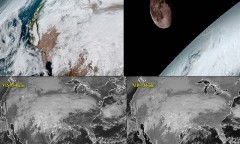By Vishal Goel, | January 25, 2017

Atacama Large Millimeter/submillimeter Array (ALMA) telescope in Chile took pictures of the millimetre-wavelength light emitted by the Sun’s chromosphere. (YouTube)
Atacama Large Millimeter/submillimeter Array (ALMA) recently released a set of images captured by its telescope that reveal an animal-like sunspot which measures nearly twice as large as the diameter of the Earth.
A sunspot is a transient feature that occurs in regions of the sun where its magnetic field is extremely concentrated and powerful. Sunspots are lower in temperature, making them appear relatively darker than the surrounding regions.
Like Us on Facebook
The images, part of the testing and verification campaign to make ALMA's solar observing capabilities available to the international astronomical community, were taken on December 18, 2015 with the Band 6 receiver at a wavelength of 1.25 millimeters.
During a 30-month period beginning in 2014, an international team of astronomers harnessed ALMA's single-antenna and array capabilities to detect and take pictures of the millimeter-wavelength light emitted by the Sun's chromosphere.
ALMA was originally designed to observe remarkably faint objects throughout the Universe such as distant galaxies and planet-forming disks around young stars. But it is also capable of studying objects in our Solar System, including planets, comets, and the sun. Understanding the heating and dynamics of the chromosphere, which is considerably hotter than the photosphere, are key areas of research addressed by ALMA.
The new images of the sun demonstrate ALMA's newly found ability to study solar activity at longer wavelengths than observed with typical solar telescopes on Earth. According to ALMA, this is an important expansion of the range of observations that can be used to probe the physics of our nearest star.
-
Use of Coronavirus Pandemic Drones Raises Privacy Concerns: Drones Spread Fear, Local Officials Say

-
Coronavirus Hampers The Delivery Of Lockheed Martin F-35 Stealth Fighters For 2020

-
Instagram Speeds Up Plans to Add Account Memorialization Feature Due to COVID-19 Deaths

-
NASA: Perseverance Plans to Bring 'Mars Rock' to Earth in 2031

-
600 Dead And 3,000 In The Hospital as Iranians Believed Drinking High-Concentrations of Alcohol Can Cure The Coronavirus

-
600 Dead And 3,000 In The Hospital as Iranians Believed Drinking High-Concentrations of Alcohol Can Cure The Coronavirus

-
COVID-19: Doctors, Nurses Use Virtual Reality to Learn New Skills in Treating Coronavirus Patients











